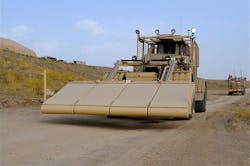Army to upgrade ground-penetrating radar system for detecting hidden IEDs buried in roadways
ALEXANDRIA, Va. – counter-landmine experts at Chemring Sensors and Electronics Systems (CSES) in Dulles, Va., will start and upgrade to a ground-penetrating radar system later this year to detect improvised explosive devices (IEDs) buried in roadways.
Officials of the Army Contracting Command-Aberdeen Proving Ground in Alexandria, Va., announced plans Wednesday to ask CSES -- formerly Non-Intrusive Technology Inc. (NIITEK) -- to make engineering changes to the CSES Husky Mounted Detection System (HMDS).
The HMDS is a counter-IED system able to detect underbelly IEDs and antitank landmines buried in primary and secondary roads. As a result, the HMDS is vital to route clearance packages (RCP). The system is a combination of the CSES VISOR 2500 ground-penetrating radar and the Husky vehicle from Critical Solutions International Inc. in Carrollton, Texas.
The Army Contracting Command will award a contract for the HMDS upgrades sometime this summer, on behalf of the Army Product Manager Counter Explosive Hazard (PdM CEH) at Fort Belvoir, Va.
The HMDS helps the Army quickly clear roadways of anti-tank mines, roadside bombs, and other IEDs. The CSES VISOR 2500 ground-penetrating radar detects metallic and non-metallic explosive hazards, pressure plates, and antitank mines. It combines advanced real-time automatic-target-recognition algorithms, integrated metallic and non-metallic threat detection, automatic precision marking, and software in a ruggedized, supportable package.
CSES’s multi-panel high-performance VISOR GPR system functions on manned, blast-resistant vehicles to provide rapid ability to scope out anti-vehicle landmines and other explosive hazards on main supply routes and additional open areas as needed, CSES officials say.
CSES’s ground-penetrating radar and an optional metal detector, when mounted on manned, blast-resistant vehicles, provides a rapid ability to scope out anti-vehicular landmines or any other type of buried explosive hazard.
CSES’s VISOR 2500 ground-penetrating radar is designed for buried mine and similar explosives detection using ultra-wideband ground-penetrating radar arrays and automatic target recognition. The system uses ultra-wide-bandwidth impulses, has a high signal to clutter ratio, low radar cross-section, is lightweight, and offers low power consumption, CSES officials say.
The HMDS program has become a program of record (POR) that requires the government to establish a baseline and configuration control of the HMDS GPR technology, Army officials say.
For additional information contact CSES online at www.niitek.com, Critical Solutions International at https://c-s-i.com, or the Army Contracting Command at www.army.mil/acc.
Ready to make a purchase? Search the Military & Aerospace Electronics Buyer's Guide for companies, new products, press releases, and videos

John Keller | Editor
John Keller is editor-in-chief of Military & Aerospace Electronics magazine, which provides extensive coverage and analysis of enabling electronic and optoelectronic technologies in military, space, and commercial aviation applications. A member of the Military & Aerospace Electronics staff since the magazine's founding in 1989, Mr. Keller took over as chief editor in 1995.

